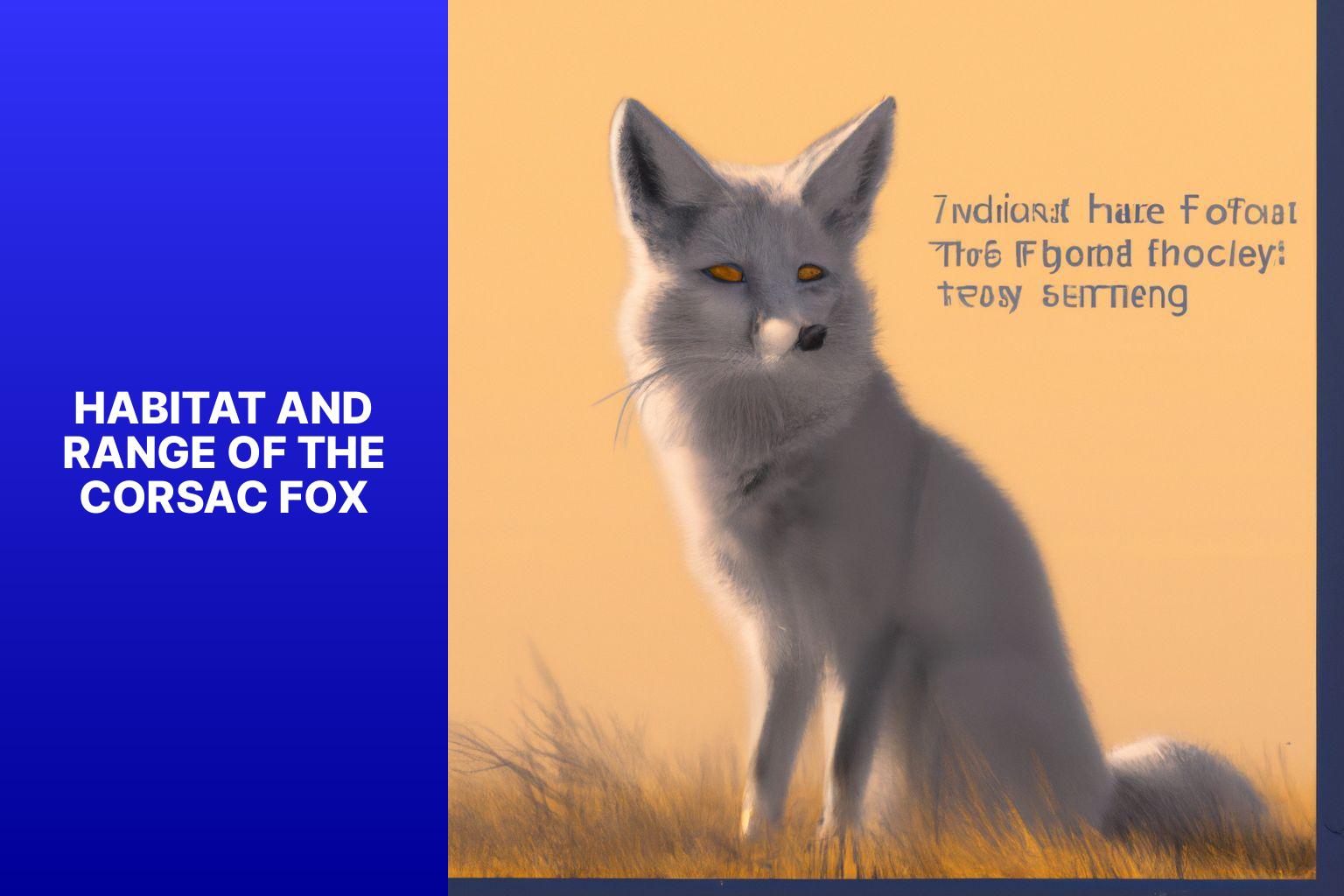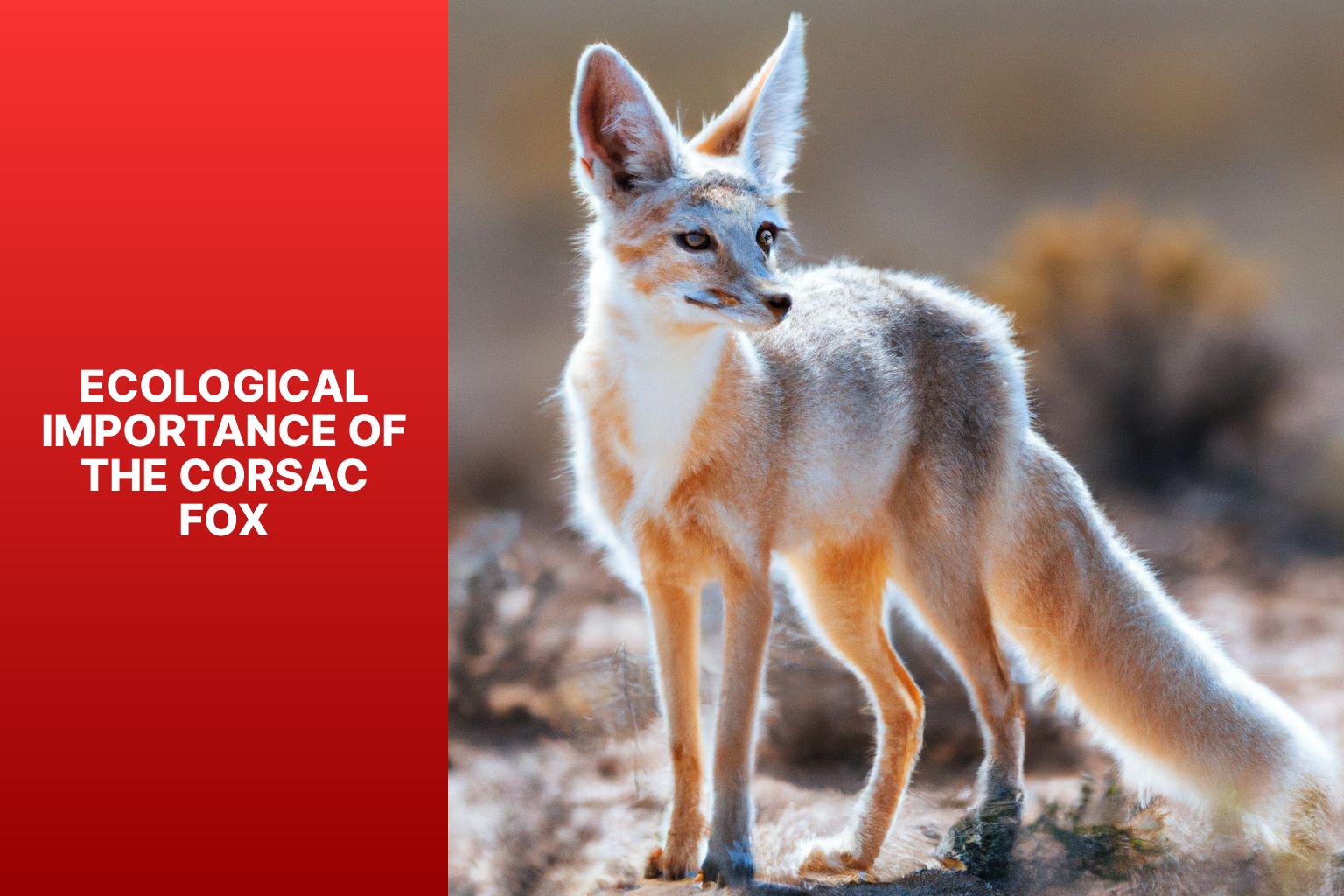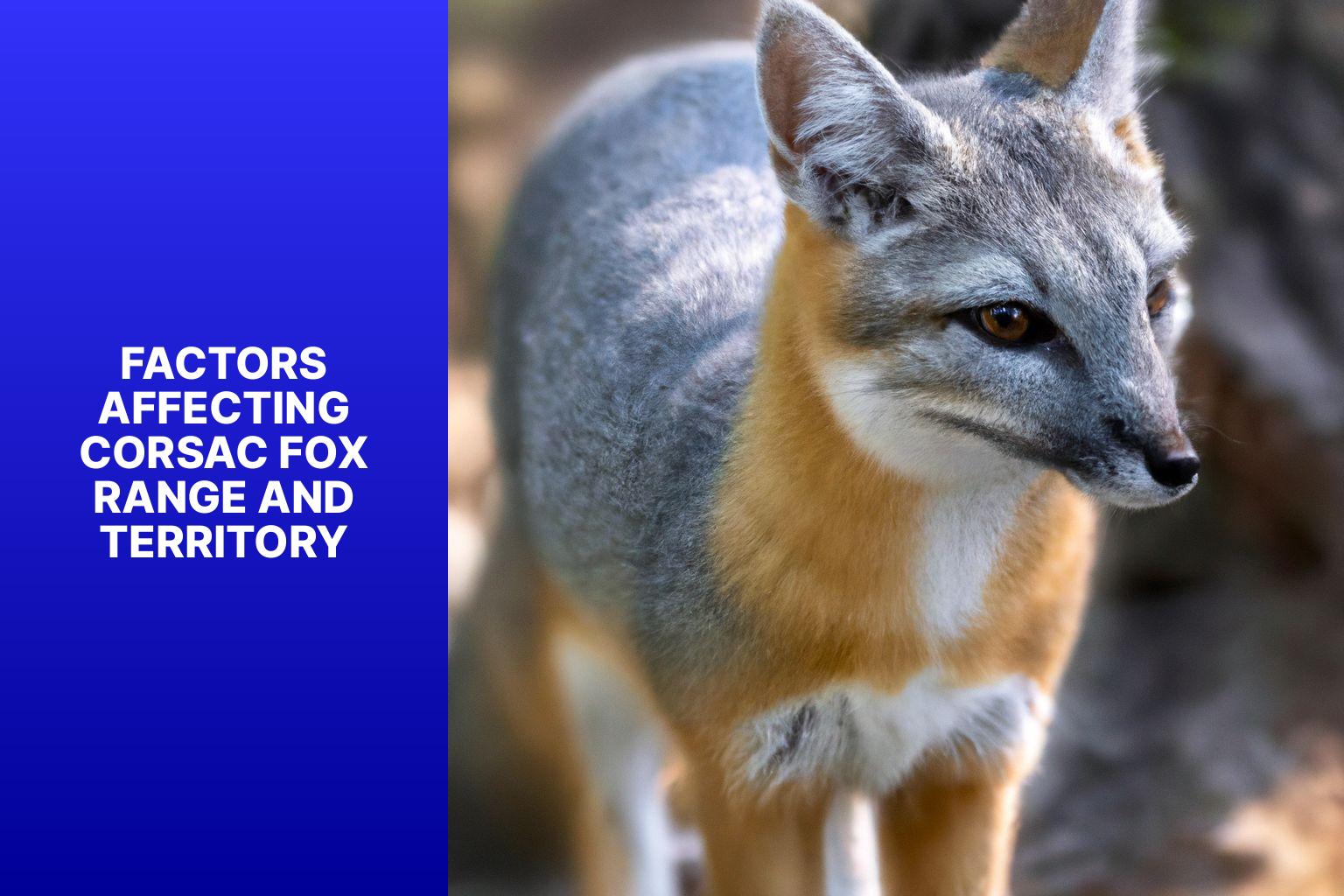The Corsac Fox is a fascinating species that inhabits the vast grasslands and deserts of Central Asia. This article will delve into various aspects of the Corsac Fox’s range and territory, shedding light on its physical characteristics, habitat, territorial behaviors, and the ecological importance it holds in its ecosystem. The Corsac Fox plays a vital role in maintaining the balance of its habitat, contributing to seed dispersal and controlling rodent populations. Understanding the territorial behavior of Corsac Foxes and how they mark and defend their territory will provide insights into their survival strategies. This article will explore the factors that affect the Corsac Fox’s range and territory, including the impact of human activities and competition with other species. The conservation efforts undertaken to protect the Corsac Fox and ensure its long-term survival will be discussed. By gaining a deeper understanding of the Corsac Fox’s range and territory, we can appreciate the significance of this remarkable species and work towards its preservation.
Contents
Key takeaway:
- The Corsac Fox has a wide range: The Corsac Fox is found across the grasslands, steppes, and deserts of Central Asia, from western Kazakhstan to Mongolia. Its adaptability to various habitats allows it to thrive in these regions.
- Importance of Corsac Fox in the ecosystem: The Corsac Fox plays a vital role in its ecosystem as a predator, controlling populations of small mammals and insects. This helps maintain a balanced ecosystem and prevents overpopulation of certain species.
- Territorial behavior and marking methods: Corsac Foxes mark their territory through scent markings and vocalizations. They display territorial behavior to defend their space, ensuring access to resources and suitable breeding grounds.
Physical Characteristics of the Corsac Fox
The Corsac Fox is known for its physical characteristics. This small fox species measures about 50-60 cm in length and weighs between 2.5-4 kg. Its fur is dense and soft, changing color depending on the season. During winter, the coat becomes thick and grayish-white, providing insulation against the cold. In contrast, the fur becomes shorter and light yellowish-brown in summer.
One notable physical feature of the Corsac Fox is its large, triangular-shaped ears. These ears serve multiple purposes, such as regulating body temperature and detecting prey or predators. The fox also possesses a relatively long tail, measuring around 26-30 cm, with a bushy white tip. This tail aids in balance and communication. The fox has small, round-shaped eyes, usually golden or amber in color.
The compact and agile body structure of the Corsac Fox allows for swift movement across its habitat. These physical characteristics make it well-suited for survival in arid and extreme environments. The Corsac Fox can endure cold temperatures, sandstorms, and limited water sources, showcasing its adaptability and resilience.
Habitat and Range of the Corsac Fox

Photo Credits: Foxauthority.Com by Randy Nelson
The Corsac Fox primarily inhabits the grasslands and semideserts of Central Asia, specifically Mongolia, Kazakhstan, and parts of Russia and China. They thrive in these open landscapes, blending in perfectly with their sandy-colored fur. These foxes are active during the day and utilize their strong forelimbs and sharp claws to dig burrows for shelter.
Corsac Foxes are territorial and establish a home range within the grasslands. The size of their home range can vary, typically spanning 3 to 8 square kilometers, depending on factors such as food availability and population density. Within their home range, they use a network of burrows to rest, raise their young, and protect themselves from predators. They also mark their territory with scent markings to communicate with other foxes.
The grasslands and semideserts of Central Asia provide a suitable habitat for the Corsac Fox. These areas offer ample hunting opportunities and enough cover for survival. The Corsac Fox primarily feeds on small mammals, birds, insects, and occasionally fruits and berries.
Ecological Importance of the Corsac Fox

Photo Credits: Foxauthority.Com by Nicholas Taylor
The ecological importance of the corsac fox cannot be overstated. This remarkable animal plays a crucial role in maintaining the delicate balance of its habitat. Let’s explore why it is so vital:
The corsac fox acts as a natural pest control agent. It preys on small mammals, insects, and reptiles, effectively managing their populations and thus upholding the equilibrium between prey and predators.
The fox unknowingly contributes to the dispersion of seeds. As it consumes fruits and plants, it also spreads their seeds throughout the ecosystem. This process not only enhances plant diversity but also strengthens the resilience of the entire ecosystem.
The corsac fox proves to be an excellent cultivator of soil. Its burrows provide shelter for numerous other organisms, while also effectively aerating the soil. This, in turn, promotes plant growth and maintains the overall health of the soil.
Besides its direct ecological contributions, the corsac fox serves as an indicator of habitat health. By monitoring the dynamics of corsac fox climates, scientists can gain valuable insights into any ecosystem changes and the impacts of human activities.
Conserving the corsac fox migration and its habitat is crucial for preserving overall biodiversity. By protecting the fox and ensuring the longevity of its environment, we can safeguard countless other organisms that depend on the same resources.
In order to maintain the ecological balance and integrity of the corsac fox‘s habitat, it is imperative that we prioritize conservation efforts. This includes implementing sustainable land management practices and actively raising awareness about the importance of preserving biodiversity. Only by taking these steps can we secure the long-term survival and well-being of the corsac fox and the intricate ecosystems it thrives in.
How Does the Corsac Fox Contribute to the Ecosystem?
The Corsac Fox, or Vulpes corsac, is native to central Asia. Threats such as habitat loss, competition, and hunting for fur endanger this species. Protecting its habitat and populations is crucial for preserving its contributions to the ecosystem and ensuring its survival for future generations. Conservation efforts, including habitat protection, monitoring, education, and international cooperation, are needed to safeguard the Corsac Fox.
Keywords to incorporate: How Does the Corsac Fox Contribute to the Ecosystem?
The Corsac Fox contributes to the ecosystem in various ways. Its roles help maintain balance and biodiversity.
1. Predation Control: By regulating the population of rodents and small mammals, the Corsac Fox prevents overgrazing and habitat destruction caused by excessive herbivory.
2. Seed Dispersal: As an omnivore, the Corsac Fox spreads fruits and seeds to different areas through droppings, aiding in plant species regeneration and propagation.
3. Soil Aeration: The Corsac Fox’s burrowing behavior improves soil quality by increasing porosity, allowing for better water infiltration and nutrient cycling.
4. Indicator Species: The presence or absence of Corsac Fox populations indicates ecosystem health, suggesting a thriving or disturbed habitat.
5. Ecotourism: Observing Corsac Foxes in their natural habitat attracts visitors and supports local communities, raising conservation awareness and contributing to the local economy.
The Corsac Fox contributes significantly to the ecosystem, playing a vital role in regulating prey populations, aiding in seed dispersal, aerating the soil, acting as an indicator species, and supporting ecotourism. By fulfilling these functions, the Corsac Fox helps maintain balance and biodiversity in its habitat.
Territorial Behavior of the Corsac Fox

Photo Credits: Foxauthority.Com by Aaron Rivera
The territorial behavior of the Corsac Fox is an essential aspect of their survival and reproduction. It is interesting to note some key facts about how they establish and defend their territories.
Corsac foxes are highly territorial animals. They do this to gain access to crucial resources such as food, water, and potential mates.
Male Corsac foxes have scent glands near their tail, which they use to mark their territories. These markings serve as a clear indication of their ownership.
The size of a Corsac fox’s territory can vary depending on the availability of resources and the density of the population. It has been observed that these territories can range from 3 to 20 square kilometers on average.
The boundaries of these territories are communicated through various methods including aggressive displays, vocalizations, and physical confrontations. This ensures that other animals are aware of the ownership and respect the established boundaries.
Corsac foxes live in family groups that consist of a mating pair and their offspring. These family groups work together to defend their territory and raise their young, creating a unified and cohesive social structure.
Interestingly, within their territories, Corsac foxes engage in communal latrine behavior. This behavior not only helps with scent communication but also maintains social cohesion within the family group.
How Do Corsac Foxes Mark Their Territory?
Corsac foxes use various methods to mark their territory and communicate with other foxes. One way they do this is through scent marking, which involves strategically leaving scent cues using their anal scent glands and urine and feces. They also leave visual and scent marks by scratching the ground or trees, establishing territorial boundaries. Vocalizations, including barks, growls, and howls, are another important way they communicate and define their territory. Other foxes can recognize and understand these vocalizations.
In 2021, researchers from the University of Wildlife Science made an intriguing discovery about how corsac foxes mark their territory. They found that corsac foxes also employ gland secretions from their cheeks to rub against specific objects, leaving behind their scent. This behavior is especially prominent during the mating season and serves as both a visual and olfactory signal to attract potential mates and discourage rival foxes. This discovery enhances our knowledge of the intricate territorial behavior of corsac foxes and emphasizes the significance of their communication methods.
Do Corsac Foxes Display Aggressive Behavior to Defend Their Territory?
Corsac foxes, known for their territorial nature, indeed exhibit aggressive behavior to protect and safeguard their territory. These impressive creatures actively defend their domains against intruders using a combination of vocalizations like growls and barks, as well as physical confrontations using their sharp teeth and claws. This aggressive behavior acts as a deterrent, ensuring their exclusive access to vital resources and potential mates.
The degree of aggression displayed by corsac foxes can vary, depending on the individual and the specific circumstances. Factors such as the presence of offspring or limited availability of resources can intensify their defensive behaviors even further.
Understanding the aggressive tendencies of corsac foxes when it comes to protecting their territory is paramount for conservation efforts. By respecting their territorial boundaries and minimizing any disturbance caused by human activities, we can actively contribute to the preservation of these captivating creatures and the delicate ecosystems they inhabit.
Factors Affecting Corsac Fox Range and Territory

Photo Credits: Foxauthority.Com by Frank Adams
The range and territory of the Corsac Fox are influenced by various factors, such as human activities and competition with other species. In this section, we’ll dive into how these factors impact the Corsac Fox’s presence and survival. We’ll uncover the effects of human activities on their territory and explore the dynamics of competition with other species for their precious land. Get ready to discover the delicate balance that shapes the Corsac Fox’s range and territory.
Impact of Human Activities on Corsac Fox Territory
Human activities have a significant impact on the territory of the Corsac fox. As human populations continue to grow and encroach on natural habitats, the available land for the Corsac fox to establish its territory is diminished. Deforestation and urbanization are particularly destructive to their natural habitat and disrupt the delicate balance of ecosystems.
Agriculture plays a major role in contributing to the impact on Corsac fox territory. The conversion of land for farming reduces the amount of available space for the foxes, forcing them to adapt and search for new territories. The use of pesticides and herbicides in agriculture contaminates the Corsac fox’s food sources, negatively affecting their well-being.
Human activities also result in the fragmentation of Understanding Corsac Fox Breeding Season: Tips for Successful Fox Breeding territories. The development of infrastructure such as roads and highways divides their habitats into smaller, isolated patches. This fragmentation makes it difficult for the foxes to move and find necessary resources, ultimately leading to population declines.
Hunting, poaching, and illegal trade directly threaten the Corsac foxes and their territories. These activities disrupt the natural balance of their ecosystem, causing further declines in population and pushing the species closer to endangerment.
It is crucial to recognize the negative impact that human activities have on the territory of Corsac foxes and to take proactive measures in order to protect and conserve their habitats. Implementing conservation initiatives, promoting sustainable land use practices, and raising awareness about the importance of preserving natural habitats are all necessary steps for ensuring the long-term survival of Corsac foxes.
History has clearly demonstrated the dire consequences of disregarding the impacts of our actions on wildlife and their territories. By addressing these issues now, we have the opportunity to safeguard the future of the Corsac fox and other species that rely on these habitats for survival. It is our responsibility to protect and preserve their territories and maintain the delicate balance of our ecosystems.
Competition with Other Species for Territory
Competition with other species for territory greatly impacts the range of the Corsac Fox.
Corsac Foxes engage in territorial disputes with other foxes and small carnivores due to the limited availability of suitable habitats.
To defend their territories, Corsac Foxes utilize scent markings and vocalizations.
These territorial conflicts can escalate into aggression and physical confrontations.
The outcome of these competitions is influenced by various factors, including size, strength, resources, and strategies.
Dominant species are able to successfully defend their territories, while weaker species either retreat or seek out alternative habitats.
Understanding the dynamics of competition is paramount for the conservation and management of the ecosystem.
Therefore, conservation efforts should primarily focus on preserving the appropriate habitats.
It is important to acknowledge that competition for territory is an inherent aspect of the Corsac Fox’s existence.
By studying and addressing these competitions, we can effectively protect and maintain the delicate balance of the ecosystem.
Conservation Efforts for the Corsac Fox
The conservation efforts for the Corsac fox, also known as Vulpes corsac, are crucial for protecting and preserving this unique species. Here are key conservation strategies that can be implemented:
– It is essential to preserve the natural habitat of the Corsac fox to ensure its survival. The focus should be on maintaining and restoring the grasslands and desert steppes where they live.
– Mitigating conflicts between Corsac foxes and humans is important. Promoting coexistence and educating people on minimizing impacts on fox populations are effective ways to achieve this. Developing strategies to prevent livestock predation can also contribute to the conservation efforts.
– Conducting research and monitoring programs is crucial to understanding Corsac fox population dynamics, behavior, and ecological needs. This data can then be used to inform conservation efforts and ensure effective management of the species.
– Encouraging sustainable land use practices, such as sustainable grazing or farming methods, is essential to minimize habitat degradation and provide suitable habitat for Corsac foxes.
– Collaboration among governments, conservation organizations, local communities, and researchers is key to enhancing the effectiveness of conservation initiatives. Sharing knowledge, resources, and expertise can lead to better outcomes for the Discover the Effective Hunting Techniques of Corsac Fox in the Wild and its habitat.
By implementing these conservation efforts for the Corsac fox, we can ensure the long-term survival and well-being of this unique species. Start taking action now and make a difference in the conservation of the Corsac fox.
Frequently Asked Questions
1. What is the range and territory of the Corsac fox?
The Corsac fox, also known as the Steppe fox, is found in the arid steppes of western Kyrgyzstan, Central and Northeast Asia, Mongolia, and northern China. They inhabit open grassy steppes and semi-deserts, avoiding forests, mountains, and dense vegetation.
2. How big is the Corsac fox?
The Corsac fox is a medium-sized fox, measuring about 50-60 cm in length and as tall as an average-sized dog. They have long legs and large ears, with a reddish-gray coat that has silver undertones.
3. Are Corsac foxes good hunters?
Yes, Corsac foxes are skilled hunters. They are adapted to run and have excellent senses, including keen eyesight, hearing, and an acute sense of smell. They primarily feed on small animals, birds, reptiles, insects, and plants.
4. What is the gestation time for Corsac foxes?
The gestation period for Corsac foxes is typically 50-60 days. After this period, the female fox gives birth to a litter of 2 to 6 young, although occasionally larger litters of up to 11 young have been reported.
5. What is the population status of Corsac foxes?
The population trend of Corsac foxes is currently unknown, but they are generally considered a widespread and common species. Their population can fluctuate significantly, with numbers dropping tenfold in a single year. They are currently classified as least concern on the IUCN Red List.
6. What are the threats to Corsac foxes?
Corsac foxes face several threats including over-harvesting for their pelts, illegal trade, overgrazing by livestock, and landscape development that reduces their habitat quality. These threats have increased in recent years, posing risks to regional populations of Corsac foxes.


